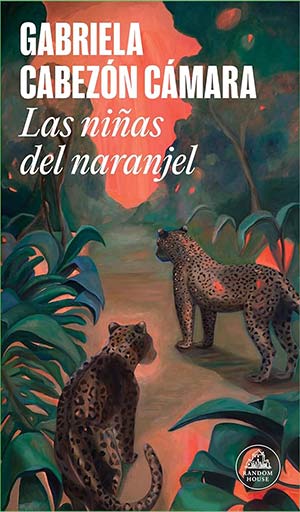Gabriela Cabezón Cámara’s Argentine Bonfire of the Vanities

In this review-essay, Laura Pensa considers Las niñas del naranjel, a historical fiction that is also intimate, deviant, and populated by other presences. Newly translated into English by Robin Myers, the book is forthcoming as We Are Green and Trembling in June 2025.
In a seventeenth-century Chaco forest blazes a fire that still burns today. A fire that ravages mountains, displaces Indigenous Peoples from their land, uproots the trees, and prevents any living thing from growing. It might not be novel to point out that writing about the past always means writing about the present, that the past only exists as something we seek, something we bring before us by pulling a taut but delicate rope. In our hands and in the rope can intertwine all kinds of willfulness, fear, anxieties, and prejudices. Perhaps what’s novel is to find fictions that embrace this premise and take responsibility for writing about the past in direct conversation with the present. We are not talking about employing the past to measure and create distance, but to illuminate responsibilities and come closer to a fire that keeps burning.
 Among the impressions that one is left with after reading Las niñas del naranjel, Gabriela Cabezón Cámara’s latest novel, I will start with those that tell me this is a historical novel and not just a tale of the past. Readers, you will emerge from this novel with dirty hands. The distance from the fire that ravages and devours the mountains will shorten, and I can guarantee you will feel somewhat responsible for the disaster. Critique—or the rewriting of official history—exists but is not linear, that is, it does not content itself with mechanically reversing the relationship between villains and heroes, nor is it about attacking the great myths head-on.
Among the impressions that one is left with after reading Las niñas del naranjel, Gabriela Cabezón Cámara’s latest novel, I will start with those that tell me this is a historical novel and not just a tale of the past. Readers, you will emerge from this novel with dirty hands. The distance from the fire that ravages and devours the mountains will shorten, and I can guarantee you will feel somewhat responsible for the disaster. Critique—or the rewriting of official history—exists but is not linear, that is, it does not content itself with mechanically reversing the relationship between villains and heroes, nor is it about attacking the great myths head-on.
Readers, you will emerge from this novel with dirty hands.
As a historical novel, its work is subtle but persistent, not only through the main character, but (perhaps above all) through the stripping away of any trace of glory and heroism from a gang of soldiers, portraying them as heartless thugs with no regard or affection for the lives of others. While rewriting them, she brings them closer, and that is where we begin to feel the heat. In a world whose (generally Western) narratives strive to mark abysmal distances from all genocidal processes of the past, the few instances where we are addressed as a present-day society involved in the continuation of predatory practices are relatively scarce. Cabezón Cámara is not propagandistic about it; in fact, she is quite sharp: she takes us through someone else’s story, an individual journey, and then, when she has us tamed, she throws a punch right in the reader’s face. The past is what it seems to be and, on top of that, a completely different thing.
Since the novel’s translation is forthcoming from New Directions, and thus perhaps you have not read it yet, I will not reveal any aspect of the plot that might spoil your experience, whether in English or Spanish. I will just say that Cabezón Cámara returns to her readers with all the strength and talent we expect from her, but she also arrives with something new, a tenderness that hadn’t appeared before. In her prose, she incorporates a Guaraní that is not foreign, because it has always been there and does not need explanation. A Guaraní understandable for those who do not know Guaraní, a conversation that does not need interpretation, a coexistence, the voice of children that is not explained by any outsider, including the author. Her work with language is so skillful that we might just find ourselves reading a seventeenth-century letter without the slightest fatigue. The great genre actualizer rebaptizes without breaking, advances with care not to disturb that creature of the past she feeds with words. With increased voracity in each of her books, Cabezón Cámara oscillates toward the margins. From the freshest, recent past of a villa to the nation-fractured past of the pampas, to an even further past, a past where none of the names we use now to name the thing fits what the thing was. The margins of the colony, the lowlands, borderlands, miscegenated, rugged, and ungovernable lands. A terrain where the forest still served as refuge, the great house of all creatures, and a vector of insurgency. We Are Green and Trembling, a most interesting translation for this title, anticipates an interspecies relationality that is at the same time futuristic and ancestral.
Following the course of the great Paraná River, near where it becomes the Paraguay, there is an area—as real as it is imaginary—where the greatest historical novels of our Argentine lowlands live. In that realm, the mother of all rivers welcomes Las niñas del naranjel and carries it in a rapid course to its earned place alongside Antonio Di Benedetto’s Zama (1956) and Libertad Demitrópulos’s Río de las Congojas (1981). A secret kindship unites these three, articulated genealogically in monologues that, never entirely central, move further away from the voices of power and great men toward the many voices that inhabited those borders and now also their hinterlands. What connects them is a mutant gene, one that expands in all of them.
Did Ventura Prieto not decide to leave Asunción to hunt himself under the name of Gaspar Toledo? Did María Muratore, la muertita, not end her life as the soldier named Fernán Brete on the coast of the River Plate? Catalina de Erauso, also known as the Lieutenant Nun and presented in this novel as Antonio, man-bird-woman, is another who dissolves between the porous limits of the early colony and embraces a life guided by choice and desire. You might say that Ventura Prieto is not the protagonist of Zama, and that is true. But Don Diego does not escape the extended family, albeit for another reason. Between that novel and this one, a line of conduct and possibilities stretches. Don Diego, the victim of waiting, is the one who did everything expected of him, met the deadlines, yearned for titles, observed manners and etiquette, and thus pursued his illusion of recognition, never achieved. Antonio runs along the reverse of that life, always escaping fixed categories, changing names, occupations, bodies, voices, ranks, languages, and even species. Changing everything that could be changed, without further discussion. Like María Muratore, with luck and a little miracle, they cross gender boundaries without the need for many explanations. With the latitude that was possible for many bodies (non-Indigenous or racialized bodies, in all cases), not so closely monitored by medical, power, and knowledge regimes that would come later. Within this filiation, in each of these novels grows the regime of visibility and attention to Indigenous peoples, bodies, and experiences. Somewhat repealed in Zama, much more present from biological and cultural miscegenation in Río de las Congojas, in Las niñas del naranjel attention focuses partly on Indigenous bodies and people, even if they are not protagonists. This is a complicated operation, but in this case, I dare to claim it successful.
Cabezón Cámara combines the most explicit scenes of violence—including a bonfire where people burn alive; the image of a pink, waxy lagoon haunted me that night in a dream—with moments of familiarity and entirely original tenderness. Particularly in Antonio’s relationship with the girls, a bond made of mutual care but also of teasing and abandonment, it becomes clear that, although his attitude and intention might align with those of a white savior, it is the girls who take care of him. They name him, feed him, dress him as a man-bird, walk him into the forest, share with him everything he needs to know to comprehend and accept the course of events. Even his own heroic will (to save the girls from captivity) twists by the force of reality: he is the outsider who needs to be cared for, for which he must first take on the task of caring.
To avoid ruining them for you, nothing should be said about the ending of the novel and some of its most accurate metaphors, but its luminous prose pulses several times to moments of absolute radiance. Las niñas del naranjel, a historical fiction that is also intimate, deviant, and populated by other presences, confirms some things we already knew and functions as a piece of futurology: the fires that will burn in the past, all fires, continue to burn.
Brown University











